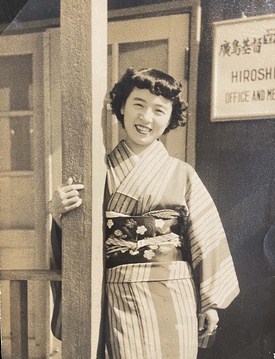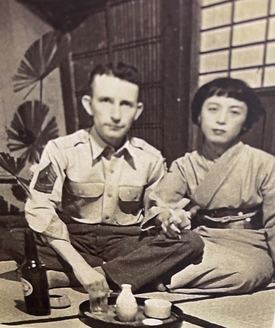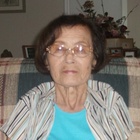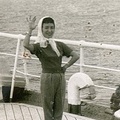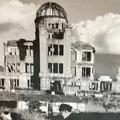Many treating the wounded in the first few weeks after the blast had not experienced early signs of radiation poisoning, so they believed that they were amid a dysentery outbreak. Survivors presenting no external issues other than singed hair suddenly had blisters or lost hair, including their eyebrows. Also, they began to vomit blood and bleed from their skin and areas of nose, ears, and gums. Thousands became stricken with purple skin spots caused by excessive bleeding under the skin later known as spots of death, an indicator that they were close to death.
Those encountering the most severe radiation, survivors amid a one-mile radius from the epicenter, died quickly as a result of organ necrosis mostly less than two days later. Lilly, who searched daily to find survivors near the epicenter and surrounding area, vividly thought back on quickly beginning to see these strange purple spots and cases of severe organ failure. Personally, she remembered feeling extremely ill, losing her hair, and bleeding internally several days afterwards.
The U.S. military, three-days following the Hiroshima bombing, dropped an additional atomic bomb on the southwest Japanese island of Kyushu—on the large harbor city Nagasaki. The citizens of Hiroshima, having all lines of communication destroyed because of their own blast, knew nothing of the Nagasaki bombing 260 miles away until weeks later. The horrendous ensued damage after two bomb drops within three days subsequently led to the announced surrender of Japan by the Emperor on August 15.
U.S. ships had previously watched in waiting for the impact of the explosion and the burning of Hiroshima just 10 miles out at sea. Once the war ended, Lilly looked back on being swiftly taken outside of the city alongside other Hiroshima women, in preparation for U.S. military soldiers to seize them.
Initial Japanese propaganda had spread that the Americans planned to rape the women, and mass amounts of young female citizens were transported to the local Mazda automobile factory to hide and form a shelter. In the factory, the women still prepared for a takeover. Lilly was issued jobs as a typist and keeping inventory of all firearms and swords from the war effort.
Once the U.S. military occupation was underway in early September and Lilly was later brought back into town, she effortlessly—yet not unexpectedly—called back to mind the strong early resentment towards U.S. presence. The Japanese military and many citizens showed little respect to the Americans, though she admitted acting with indifference on the matter. Lilly in time returned to a normal life as much as she possibly could, except not without reminders of the bombing through its visible effects. Times were hard; she and her family continued to live in shelters, surviving on only canned food. Unemployment was extremely high. Lilly recollected herself, although barely, as things progressed in the early stages of the occupation.
Unemployment was extremely high, a multitude of young women who had lost their husbands or family became prostitutes just to survive. Furthermore, an untold number of survivors walked about town searching for food, showing their severe visible scarring and disfiguration. Next, unexpectedly, miscarriages and birth defects slowly began to be noticed from women pregnant during the blast and those that became pregnant shortly afterwards.
Lilly spent hundreds of hours at or near the bomb’s epicenter following the bomb’s detonation. She was unwittingly exposed to the unseen high radiation levels; around two years later, she began to feel extremely ill from the radiation. As a result of losing her hair and developing an intestinal infection, she went to the Red Cross Hospital to receive care.
The building itself created awful anxiety from the start. The building had no windows, and there was a heavy infestation of flies along with a shortage of doctors. Once admitted to the hospital, the infection worsened. Post-surgery her abdomen was left exposed to the air and packed daily using gauze in hopes that it would heal, but this was followed by an elevating fever and resulting catatonic state.
Finally, her problems exacerbated to the point of being pronounced dead, except this was not the actual case. Astonishingly, everyone’s voices rang clear in her mind—including those words regarding her fate—as she laid there listening, still unable to communicate back. Then, as they began to roll her to the morgue her mother, now holding her hand, felt a small twitch of her fingers. This small yet significant quiver of movement instantly created tears of ecstatic joy as they realized she was alive. Proceeded from this life altering episode the medical staff worked diligently in caring for her, monitoring her status more closely, and in two months she surprisingly went on to recover.
Amid the occupation, the U.S. military had a heavy presence throughout Japan and was working on a new government. Meanwhile, the British Commonwealth of Forces supervised the demilitarization with headquarters based near Hiroshima until the full occupation ended in April of 1952. Throughout the occupation not many Americans were seen in or around Hiroshima; however, as the scheduled Allied occupancy ended, this all changed. The British Commonwealth Occupation Force ended its military activities and, even though Japan sovereignty was restored, a U.S. military presence continued.
During this time, Lilly began concentrating on her career employed in advertising at the widely regarded Asahi Newspaper, and did not have any time to date or focus on a courtship. Due to the fact that her physical beauty was not scarred from the blast, she became an object of desire by many male coworkers in her company.
This time period brought about a host of suitors asking for her hand in marriage; however, she was not interested in the long-established Japanese marriages like her parents’ and the many others’ before her. Lilly spoke of the displeasure she had as her mother deferred without question any acts of her father, and not standing up for herself. Her mother refused to call him out on his behavior, such as leaving the family alone for numerous days at a time supposedly for work, and felt he was needed at home more to help share the responsibilities.
Lilly’s girlfriend, who was fluent in English and had an American boyfriend, invited her to take a bus outside of the city to meet him. Her friend, concerned with Lilly’s recent lack of companionship, had hopes she could find someone to go to the movies with—a popular event at that time.
Upon arriving and with a little orchestrated preplanning on her friend’s part, Lilly was introduced to another young soldier—a U.S. Army Master Sergeant named Lloyd Krohn—stationed at the nearby Hiro Ammunition Depot. That evening they all attended the movies, and this initial introduction went well as her girlfriend sat between them to interpret. Later, they continued dating in groups or with another couple and their relationship blossomed.
Lilly fondly admitted dating was difficult, realizing her sheltered life growing up played a factor, though mostly it was due to her poor ability to speak English. She laughingly would say that the only English words she knew at the time were Hello and Goodbye, and when trying to learn English, sounding any word starting with the letter F was especially difficult.
Lloyd was born in south central Missouri in 1925. He was raised in Sheridan, Wyoming, a hardworking western town with deeply rooted Native American and blended rodeo influences. This town sat in the north central part of the state less than a 3-hour drive from the Montana border. He had a poor upbringing, experiencing rough times as a family, causing him and his older brother Ross to begin work at ages 7 and 9 to help with the family finances. They became young farm hands, herding sheep and cattle along with pulling sugar beets for the local sugar beet factory. Lloyd joined the Army at age 18 amid WWII, carrying out his war time commitments and sending money and gifts back to his struggling family.
Throughout Lilly and Lloyd’s courtship, she became enamored by something new to her: the American customs of chivalry by opening of doors, pulling out chairs, along with many other gestures of courtesy that he exhibited without hesitation. Also, the attitude of “ladies first” seemingly enchanted Lilly amongst many other Japanese women that encountered the American soldiers. Lloyd was such a gentleman as she remembered, initially stunned by his action of standing up when she first entered a room or approached a dining table.
Although a positive for Lilly, Lloyd experienced things he was not accustomed to as well. He faced some resentment from her family due to not being Japanese, not to mention he was a soldier in the American military. One such example of this resentment was that he was only allowed to enter her parents’ home through the back door when visiting. In Japanese custom, only those of Japanese lineage and of high respect were allowed entrance through the front.
In the end, this did not sway Lloyd because he had other plans. His feelings grew to the point of bringing an interpreter to Lilly’s home to speak to her family, most importantly her father, to ask for permission to marry his oldest daughter. This was unbeknownst to her, and she vividly looked back on arriving home seeing the strange faces of her family sitting in the living room. Lilly quickly sensed something had occurred; above all, she recognized the disapproval on her father’s face. She was in amazement and felt somewhat awkward from the proposal. Nevertheless an exuberant ‘yes’ was given, and the pre-wedding plans were set in motion.
Lilly began a training program for young, Japanese women who planned to become military housewives and move away to the U.S. This “bride school” training, provided by the Red Cross, was created to help ease any adjustment difficulty in their new country upon waiting for the arduous applied paperwork to be approved. The Red Cross focused on lessons of etiquette and instructions on things such as how to work a clothes dryer, cook using pound and cup cooking measurements, and even deal with American in-laws. Additionally, they were taught unordinary tasks like how to wear makeup, and the always difficult ‘art’ of walking in high heels. This was all much different than tea ceremony etiquette and proper floral arrangement that many women studied before a customary Japanese wedding.
Eventually, in November of 1955, Lilly was married in Hiroshima at the age of 31. Now she was identified as a War Bride determined by the post WWII War Brides Act, allowing her and other immigrant spouses to enter the country without restrictions. Lilly never viewed the U.S. as the enemy, although this decision to move was not an easy one. This was complicated by the fact that she was moving to an immense foreign land accompanying one of its soldiers.
For distinct reasoning, however, there was another concern that weighed on her mind as within Japanese custom: it was Lilly’s responsibility as the oldest child to make sure her parents were properly cared for as they aged, something she wouldn’t be able to do from the U.S. She still followed her heart and moved to the U.S. a year after marrying when Lloyd had reassignment, although the transition was not made without difficulty.
© 2022 Jon Stroud


